From Swakopmund via Walvis Bay to Sossusvlei and the Auas Mountains
It´s the last part of our round trip through Namibia. But we still have some days left. Now we head via Walvis Bay to Sossusvlei. Zum deutschen Blog.
This post contains unpaid advertisement and affiliate links.
Today we say goodbye to Swakopmund, probably the most German city outside Germany. We get picked up by Ocean Adventures from our accommodation Sea Breeze in Swakopmund. We all want to make an additional half day boat trip. The road to
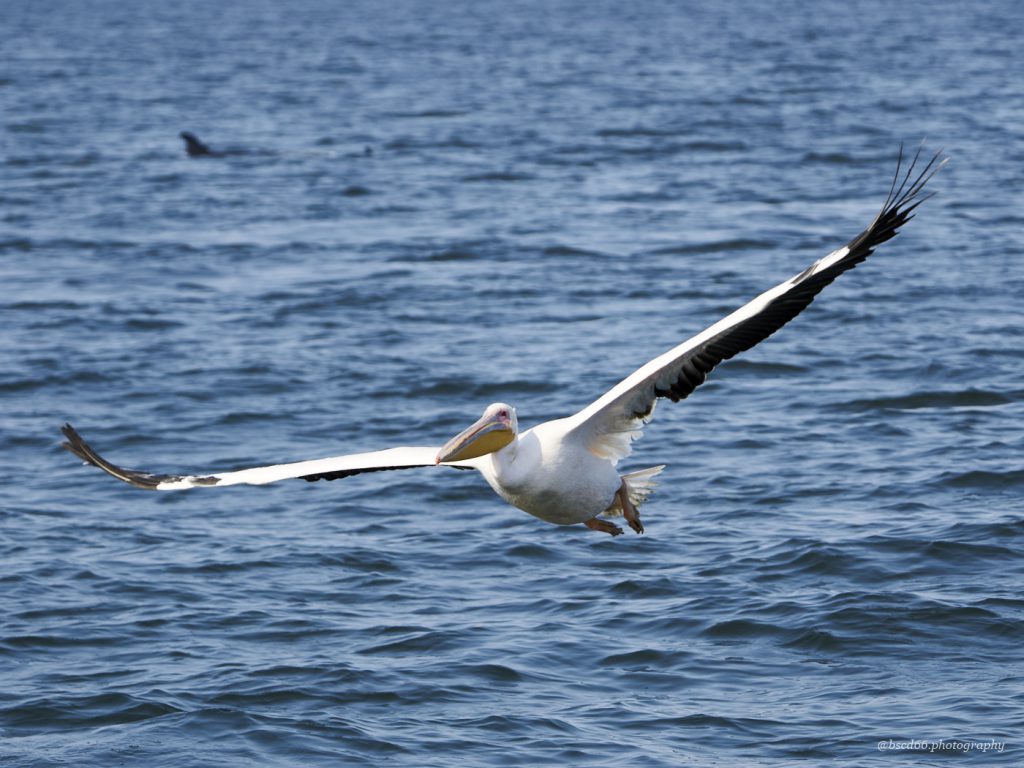
Walvis Bay
leads along the sea. It’s still quite misty and cold, but we are all well coated in several layers, in Swakopmund it’s much cooler than in the mountains.
A single flamingo swims in the harbor of Walvis Bay. With its pink plumage, it stands out wonderfully from the dark blue waters of the dock. Quickly we board our boat and we are barely two minutes “at sea”, when there is a big “Splash” and a mighty powerful seal swings into our boat and lies right in the middle of us! This is not uncommon, because these intelligent marine mammals quickly got to know that they would get some treats in form of fish. Some are actually so tame that you can touch them. However, the skipper warns us against this specimen. Photos are fine, but don´t touch. And when I see its teeth like that, then I’d rather leave it.
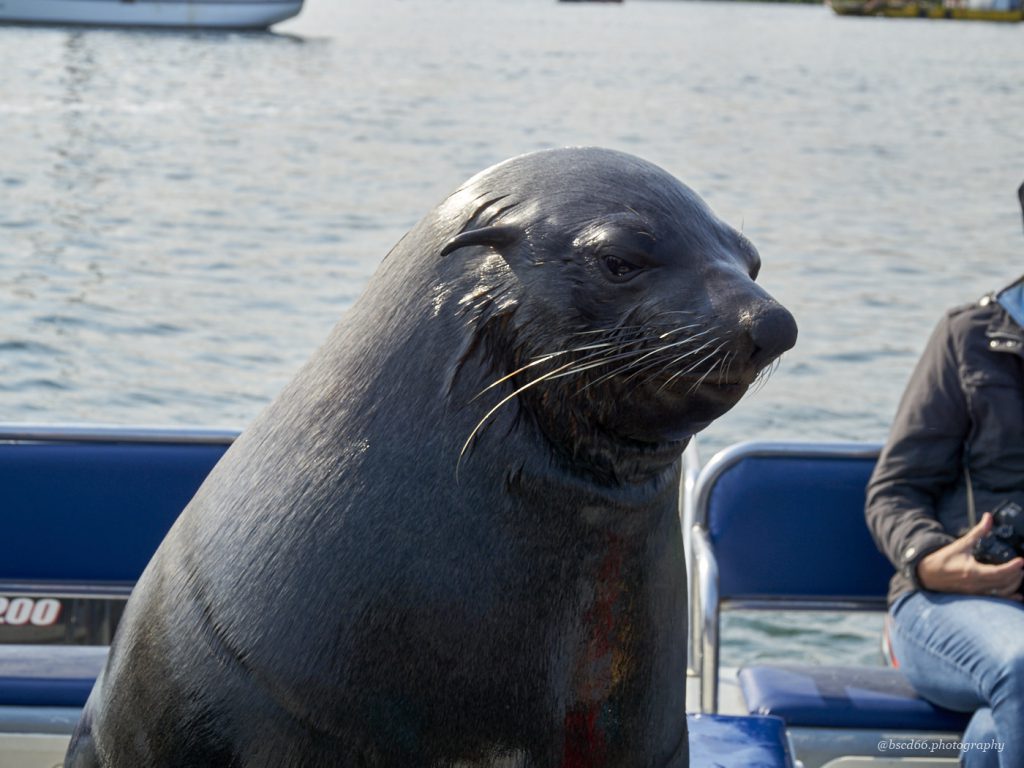
On Board
Soon after the sort visit of the seal, pelicans swirl around us, who also like to take a short break on board. We are greeted with a drink and then the captain speeds away with us, because whales and dolphins were spotted! Of course, we all want to see them. A humpback whale and several dolphins seem to have found a real treat right under the sea surface. Again and again we see the dorsal fins or the back. There seems to be a large flock of fish there, which the dolphins and also the whale do not want to miss.
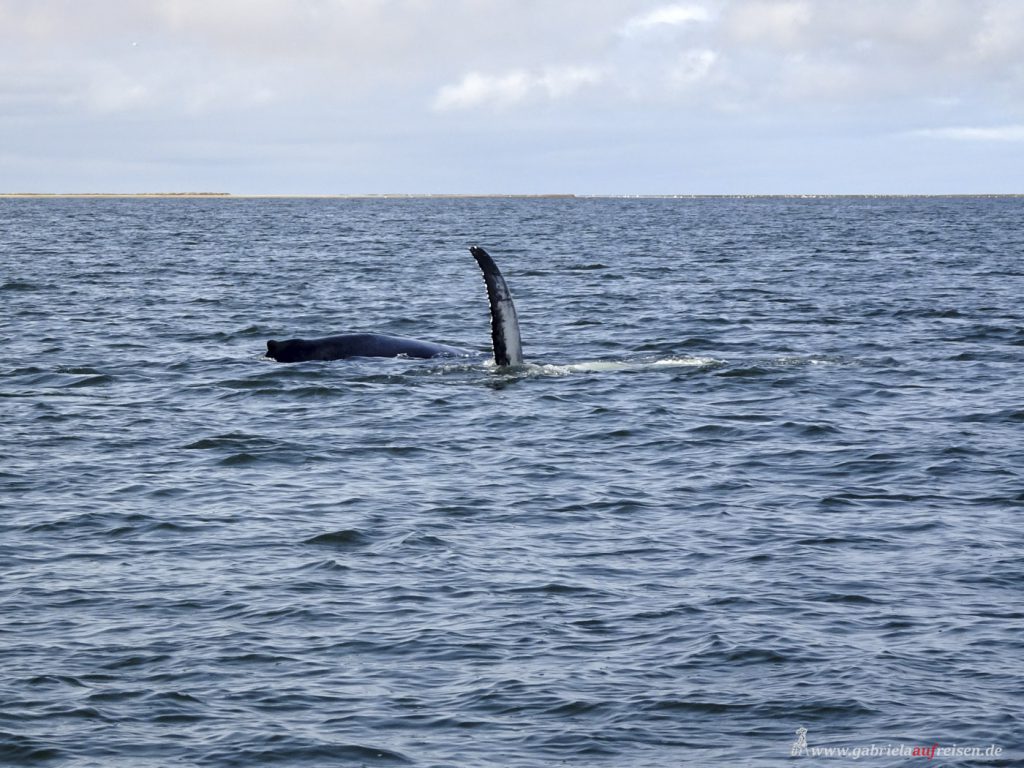
Unfortunately, we can’t stay too long, because of course everyone wants to go to the seal banks, which are located around the lighthouse of Walvis Bay. There they are! Thousands of animals lie in the sand and enjoy the sun that is shining now or they romp around in the sea. They fight for the best places and make a pagan spectacle! What a hustle and bustle!
We drive a little further and behind the sandbanks, we see another whale, unfortunately only briefly, because it is just diving. Here, just before the entrance to the natural harbor, many ships are lying in the roads, also two drilling rigs are waiting here for their new destination. And everywhere we see the curious seals in the water. Mostly they romp around and again we spot some of the arrow-fast dolphins.
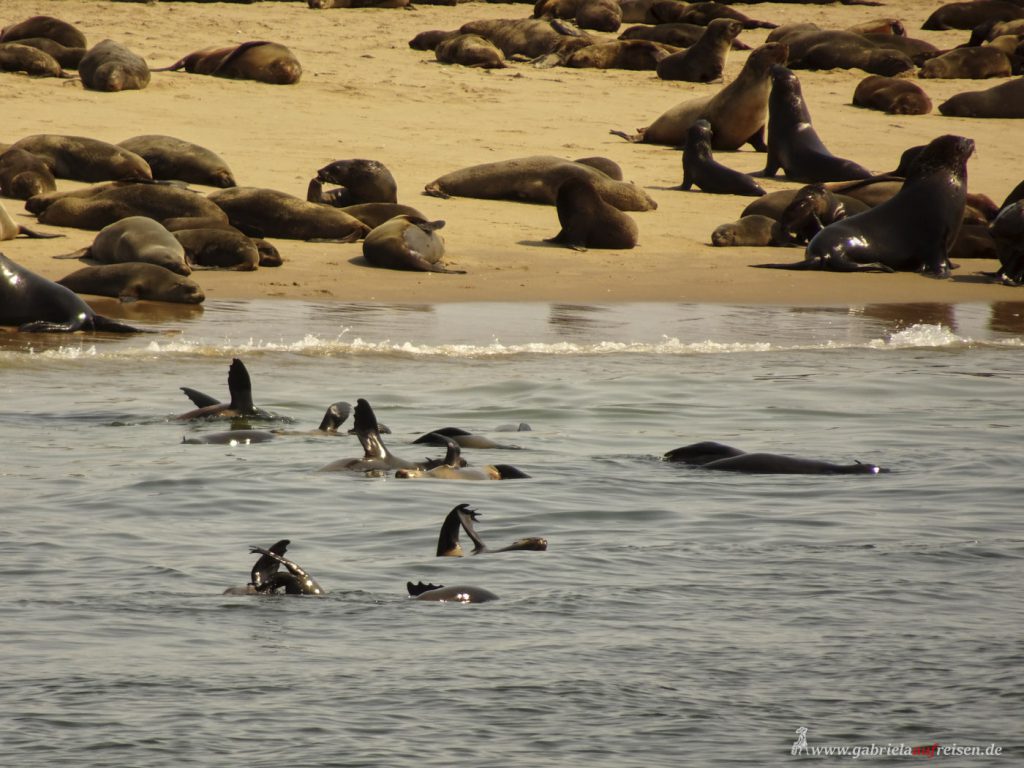
Nobody wants to go back, but Jörn, our tour guide is waiting for us. We still have a long way to go, back to the barren and hot desert, this time to the Sossusvlei, which we were able to see yesterday from above.
Unfortunately, we must wait for him for quite a while, because when starting the bus in Swakopmund, he noticed that our bus is losing oil. This must, of course, be fixed first. So, we pass the time here at the pier and watch the pelicans during their aerobatic flights. Since there is a café and also a bar and a restaurant, we can spend the time well.
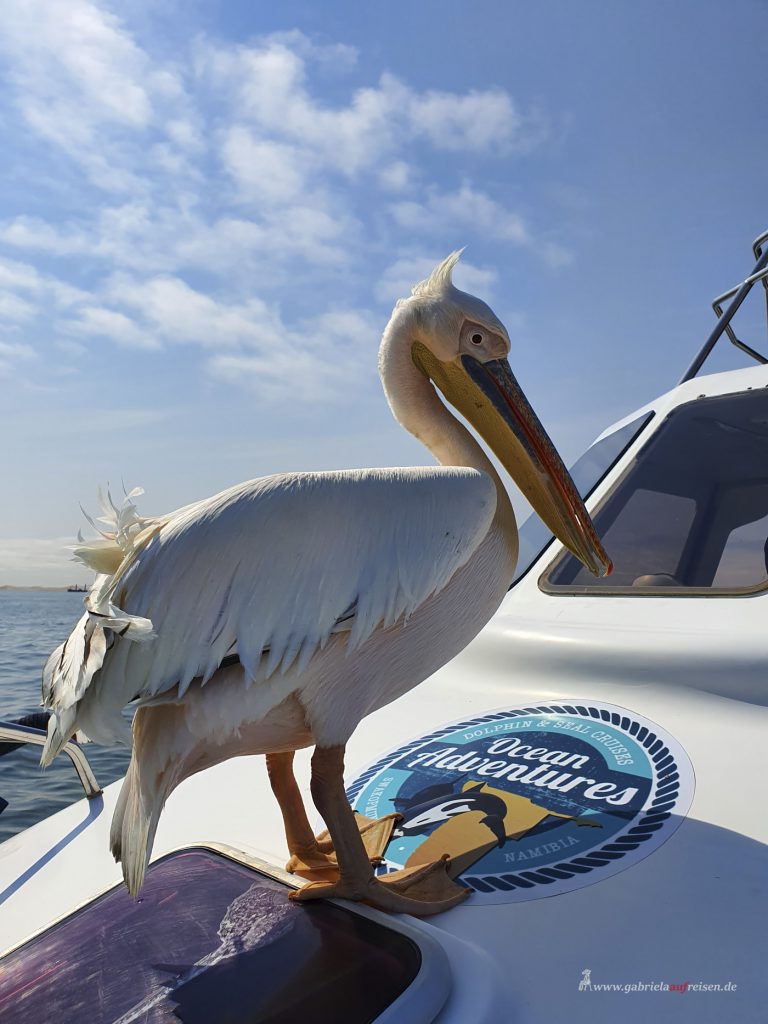
Namib Naukluft Park
From Walvis Bay, at first the road is tarred and quickly takes us into the vastness of the desert. Here the sand is a very bright yellow. Then it gets more mountainous and we end up in the black mountains of the Namib-Naukluft-Park. It is so incredibly barren here and yet we see Oryx, who still find enough food in the valleys of the bare mountain range. It is also the place where the real story of Henno Martin’s novel “A Sheltering Desert” took place. I highly recommend this novel, because it testifies the will to survive in this area very impressively.
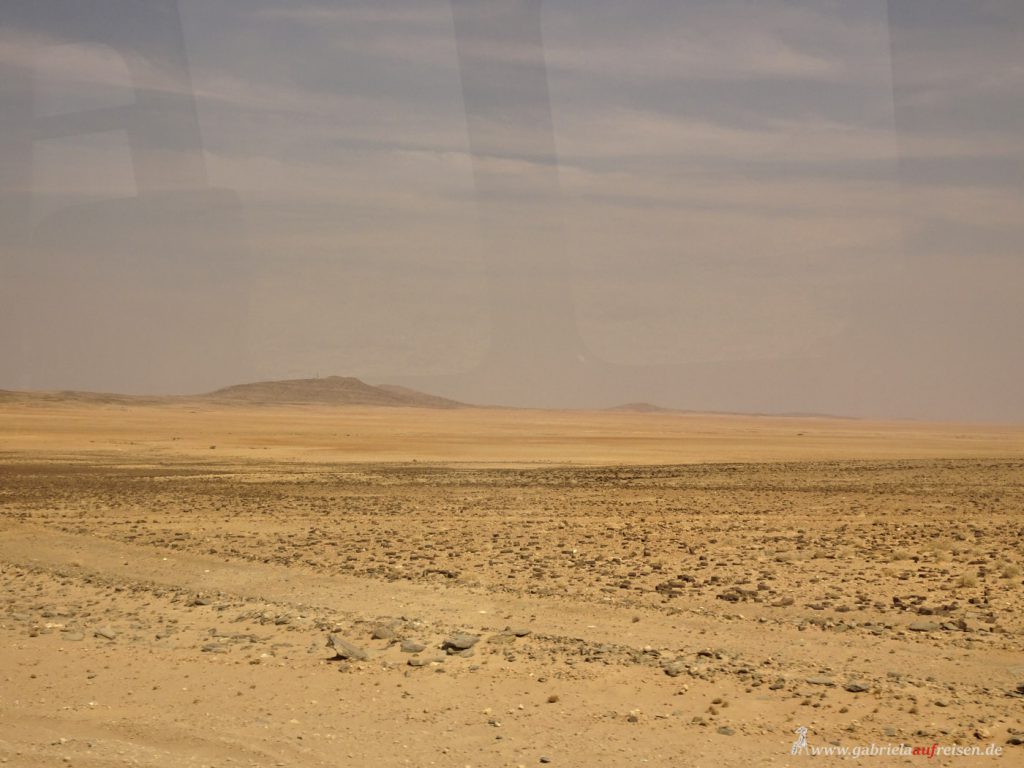
Due to our delayed departure in Walvis Bay, we don’t arrive until sunset at our next accommodation, the
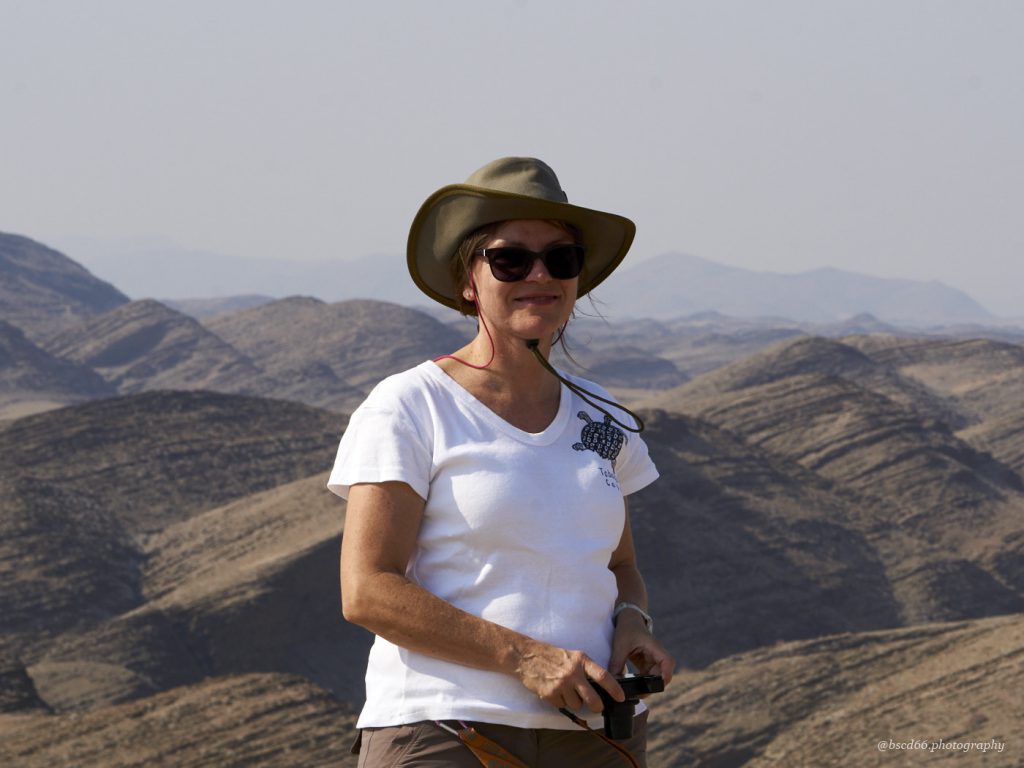
Namib Desert Lodge
which is located at the foot of a petrified dune. It is precisely in this light that it shows us the incomparably red color, it seems to glow! It is such a dune as we will see it tomorrow in the Sossusvlei, only much older. The dunes in the Sossusvlei also begin to petrify and in many millions of years, they will probably look like this one. How will it look like on our planet then? Who knows…
We indulge in the buffet before we fall into our beds in the spacious cabins. The night is short, because we have to get up and, on our way, very early. It is about a one-hour drive to Sossusvlei National Park and there the gate opens again at sunrise.
We don’t want to miss that, so we get shaken up in the dark on this really bad road. Slowly we can see some contours of the surrounding mountains. There is already the sign to the entrance of the park.
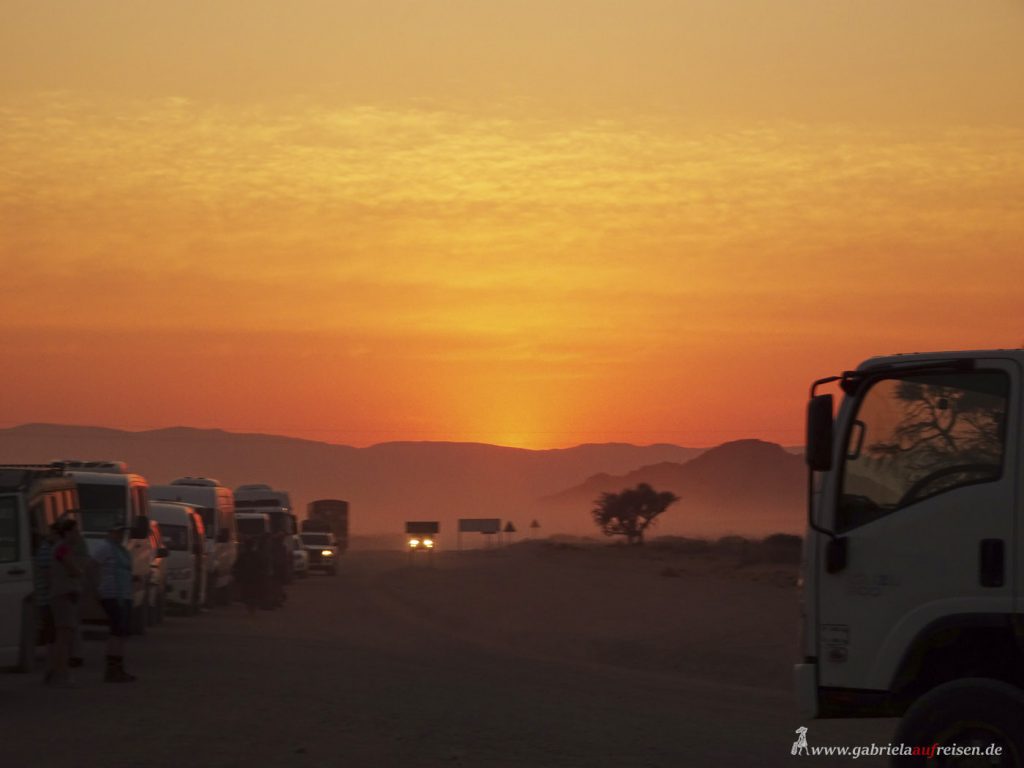
Sossusvlei
We are not the first in the queue, but quite at the front. First we enjoy the rising of the sun. This is really an absolute spectacle and turns everything around us orange and red. So beautiful!
Then Jörn drives with us into the Sossusvlei National Park. There are still about 60 km of well-maintained road ahead of us. We are all hungry and so we open our well-stocked breakfast boxes.
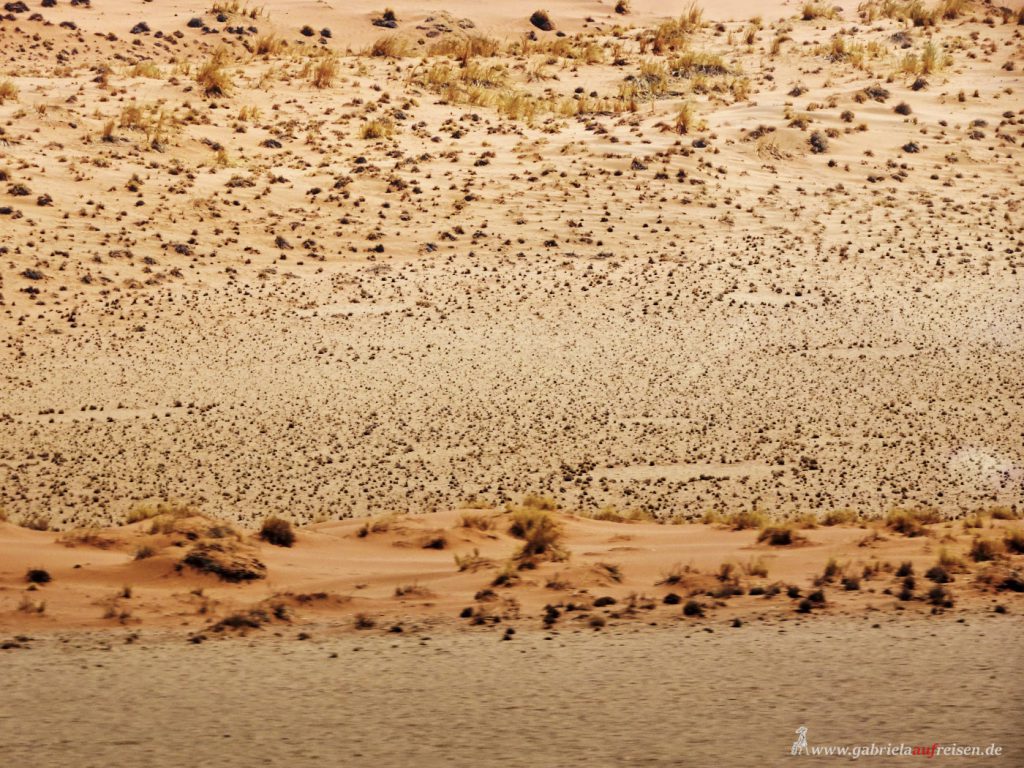
Jörn explains a bit about the fairy circles, which you can see here very well. They are circles in the grass where nothing grows. It is not yet absolutely clear why, but the most likely theory is termites, which eat the grass roots to give their underground construction an even temperature.
We stop at a large parking lot. There is an endemic white spider here. Unfortunately, it is repeatedly taken out of her habitat by uncareful guides and then it mostly dies. It should be enough to show the small creature in its natural surroundings and just let it stay there!
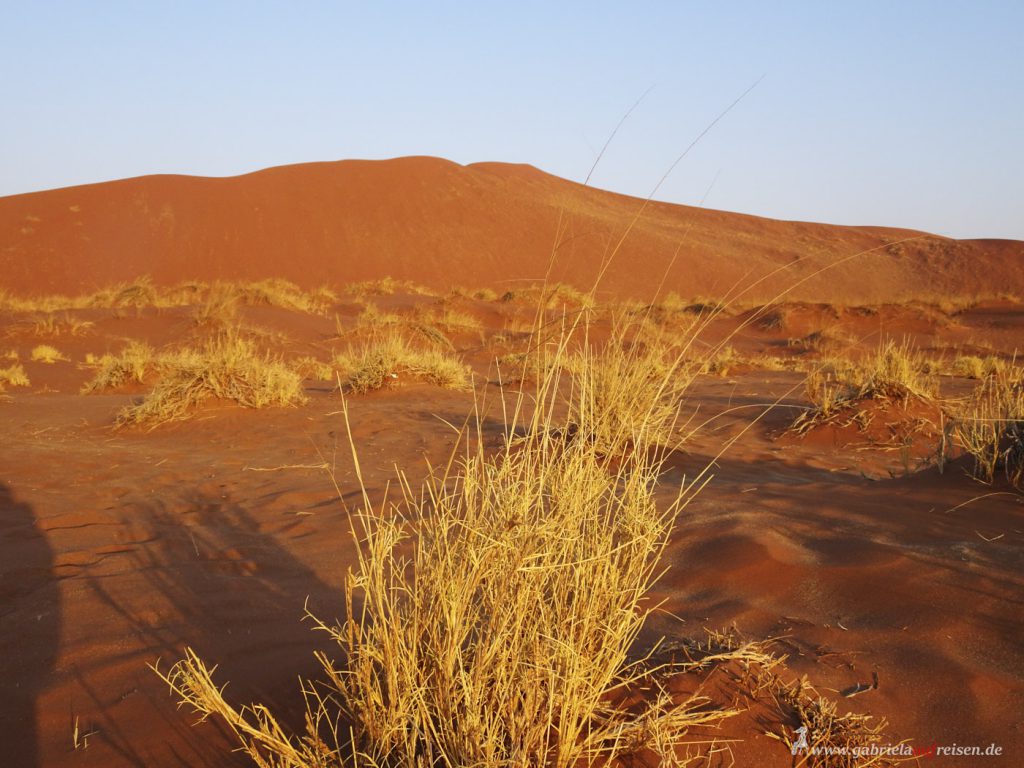
We need to go further, because we want to climb the great dunes of the Sossusvlei. Only a few are open to the public for climbing and this is fine and it gets controlled by the rangers. The first open dune is No. 45. There are already many buses parked and whole armies trying to get up on the crest of the dune. Since many tour operators travel no further than to this point, the tourists miss out of the Dead Vlei in Sossusvlei, with its white salt pans and the dead trees.
Good for us, then it’s not so crowded! At the end of the road this parking lot is also quite crowded. Here is also the last option for a “normal” toilet. The queue in front of it bears witness to this. Here everyone must change from their buses into open jeeps, because the road is now only a sand track with deep, soft sand. For this, the wheels of the jeeps have less air pressure. We must wait a little while before it is our turn. The rangers try to explain to some Chinese who come after us that queuing is the thing. Simply boarding the jeeps does not work.
The last five kilometers to the
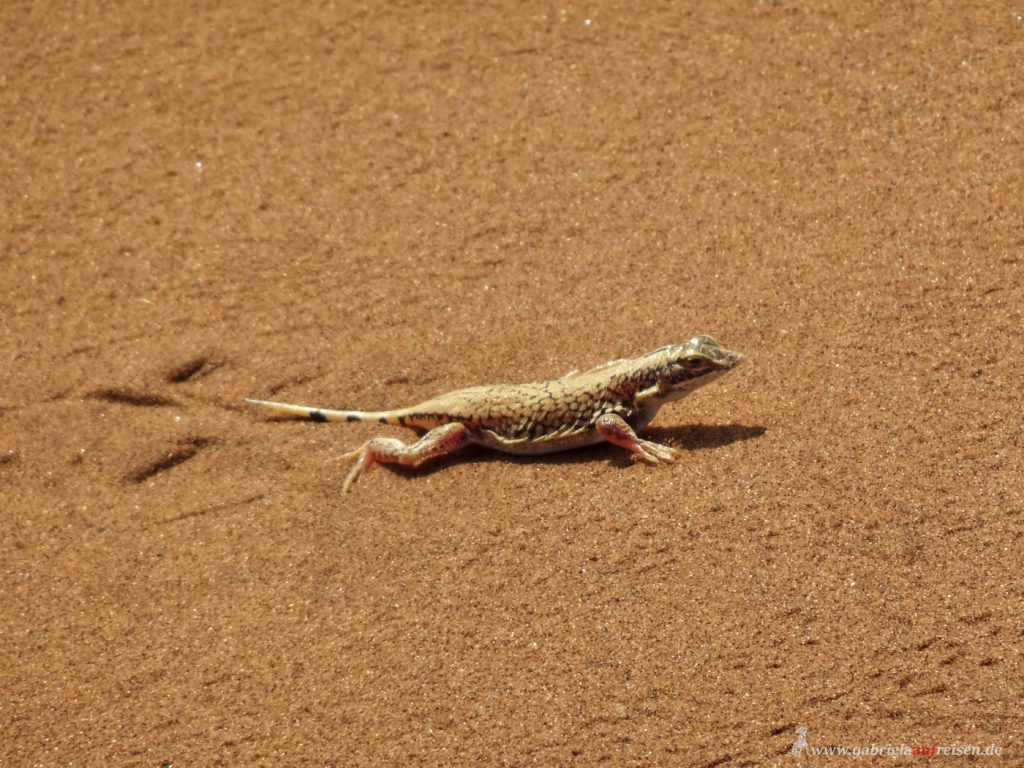
Dead Vlei
soon done. We drive past “Big Mama”, a dune that I climbed 13 years ago.
We drive until the end, to “Big Daddy”, an even bigger dune. In the meantime, it is already quite hot and who wants to climb the dunes, should take enough to drink and should take a hat. The climb on top of “Big Daddy” and back through the salt pan can be done in 1.5 to 2 hours, but the ascent is very steep, because about 300 meters of altitude are covered with fine, soft sand.
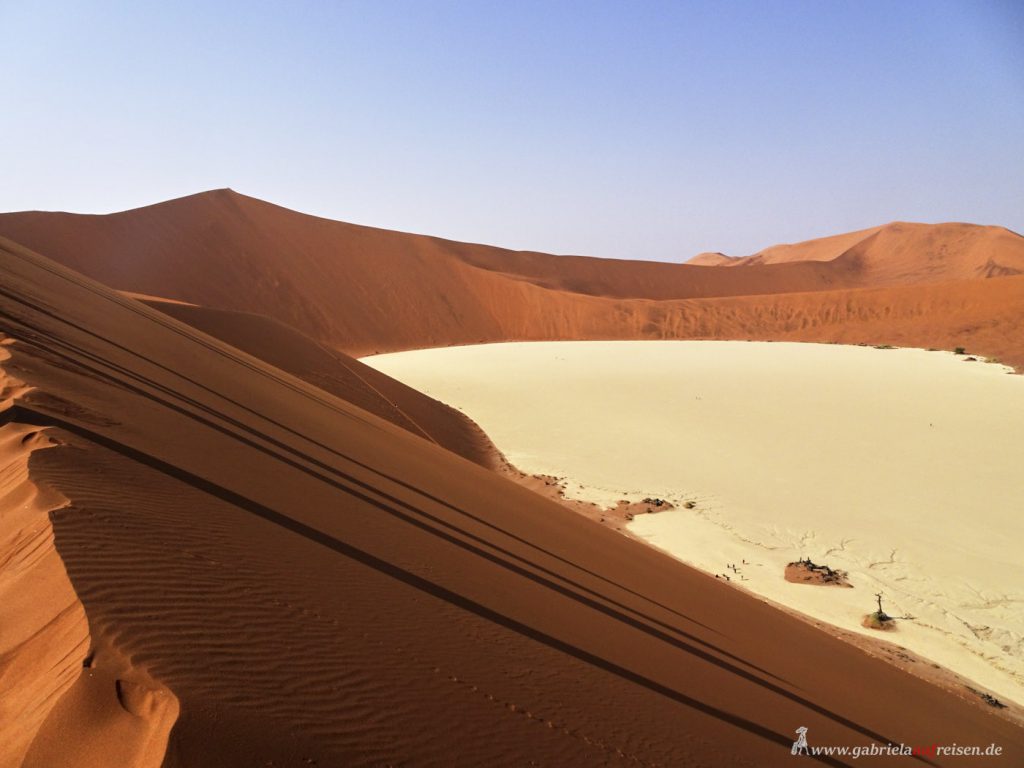
I opt for the slightly less steep variant, the dune to the right of “Big Daddy”. It has a slightly less steep climb and is not quite as high. That is enough for me. That’s how our group splits up. A few stay under a huge tree and pay attention to our luggage that we leave here and those who follow me and of course the quite sporty ones who want to make it to the top. As soon as I arrive at the top, I can see the famous salt pan of the Sossusvlei with its camel thorn trees, which have died about 500 years ago. This pan was separated from the plain by a small sand dune. So, these trees could not get any water from the Tsauchab river since the formation of the small dune. This river fills the valley about every 10 years and stays here as a lake for some time. The water cannot seep into the earth due to the nature of the clay soil.
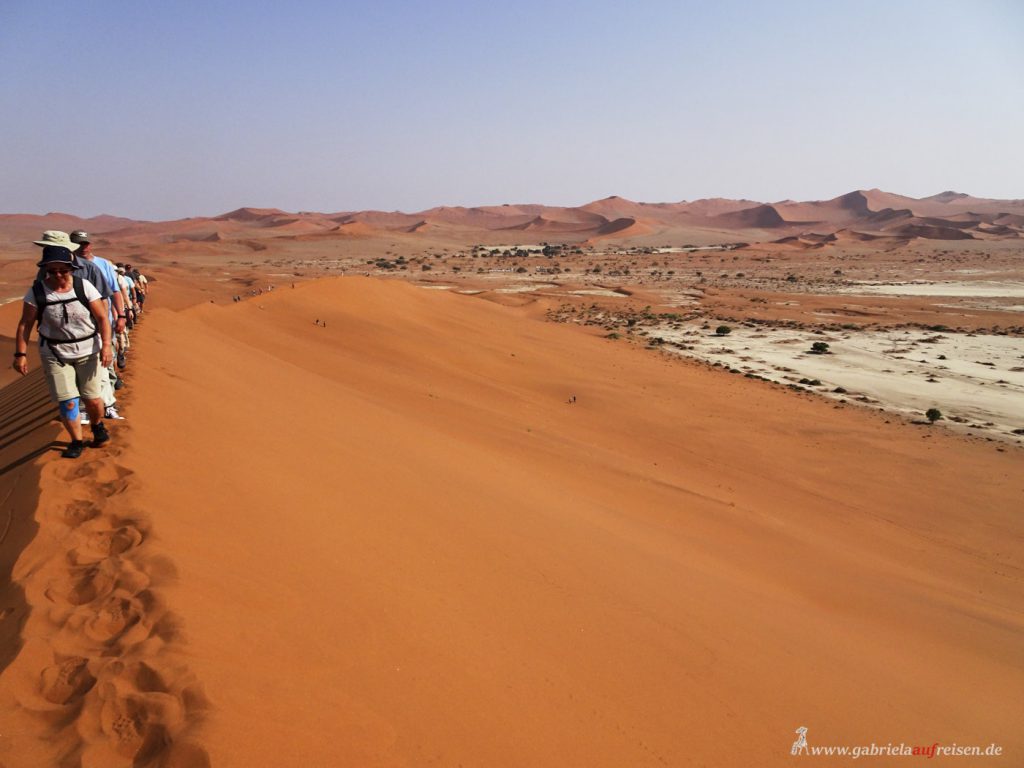
The trees are a very sought-after photo motif, but they really look bizarre! We descend through the deep sand to the salt pan and now of course we also take our photos. On the other side of the valley we still see green trees. They stand along a dry river. There still seems to be enough groundwater here, so that these trees do not die. Rock paintings of indigenous people are also said to be here. Unfortunately, we haven’t got enough time to explore this, because the jeeps are waiting for us to take us back to the parking lot.
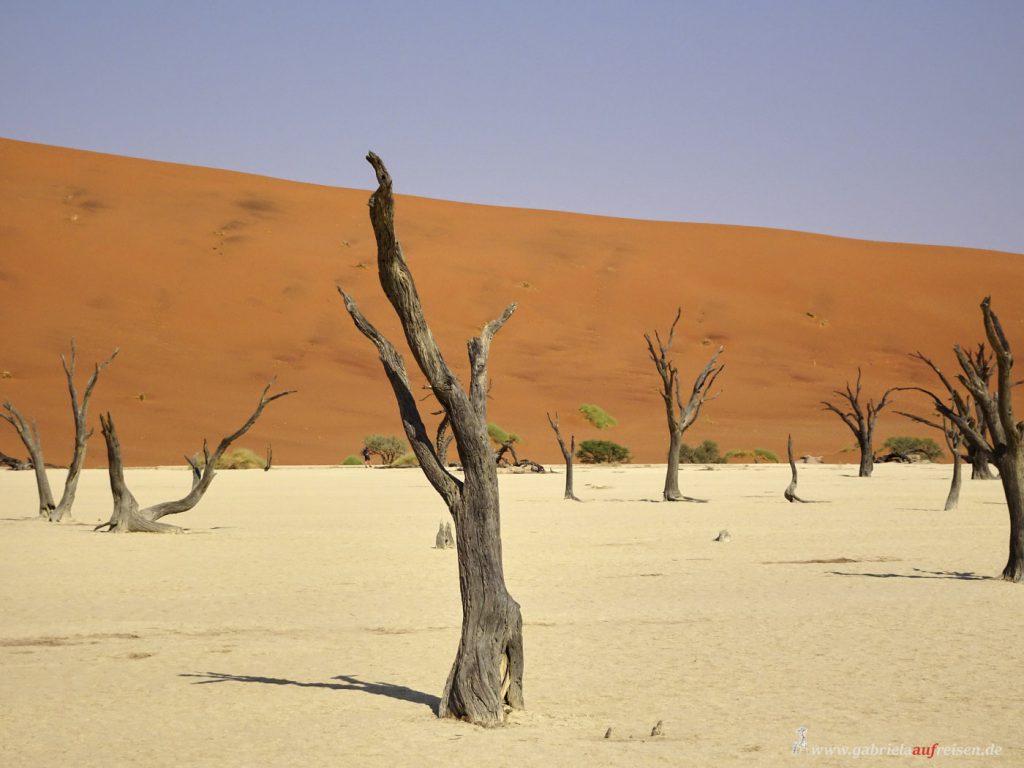
In front of the bus we can say, “I still have sand in my shoes”, not from Hawaii, but from the Sossusvlei. What a beautiful experience! These red dunes, which have their color of the iron parts in the sand. For me, this visit here was an absolute highlight of this trip! There is nothing like these gigantic sand dunes, which are a UNESCO World Heritage Site.
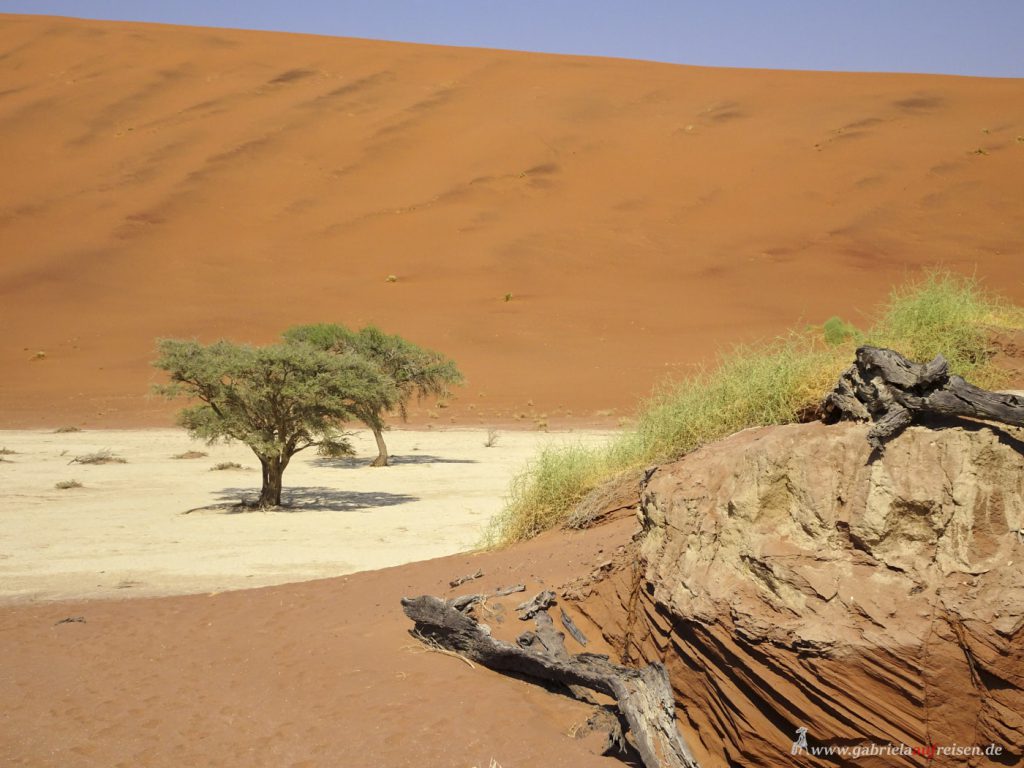
Sesriem Canyon
Just behind the gate to the park, turn right to the Sesriem Canyon, which regularly carries water during the rainy season, but is now dust dry. A path leads down and through. There are lots of holes that were drilled by wind and weather into the rock. A huge flood a few years ago wedged tree trunks in the rocks far above us. I can hardly believe how high the water must have been.
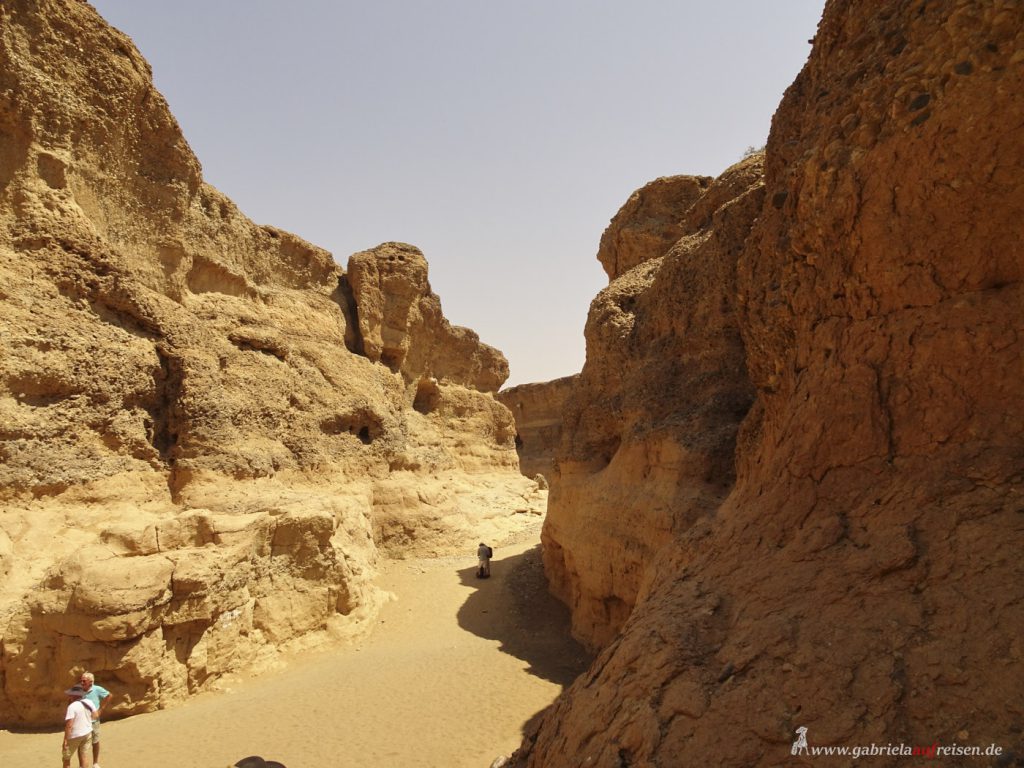
In the early afternoon we are back at
Namib Desert Lodge game drive
. Here I refresh myself in the pool and only a little later we start to the game drive up and around the petrified dune.
Our guide explains a lot about the unique location of the lodge and the geological nature of the dune here, before we drive up over winding paths. We see lonely oryxes and their droppings that mark their territory. They look like coffee beans. Our guide shows us that they are even edible, but I don’t try them.
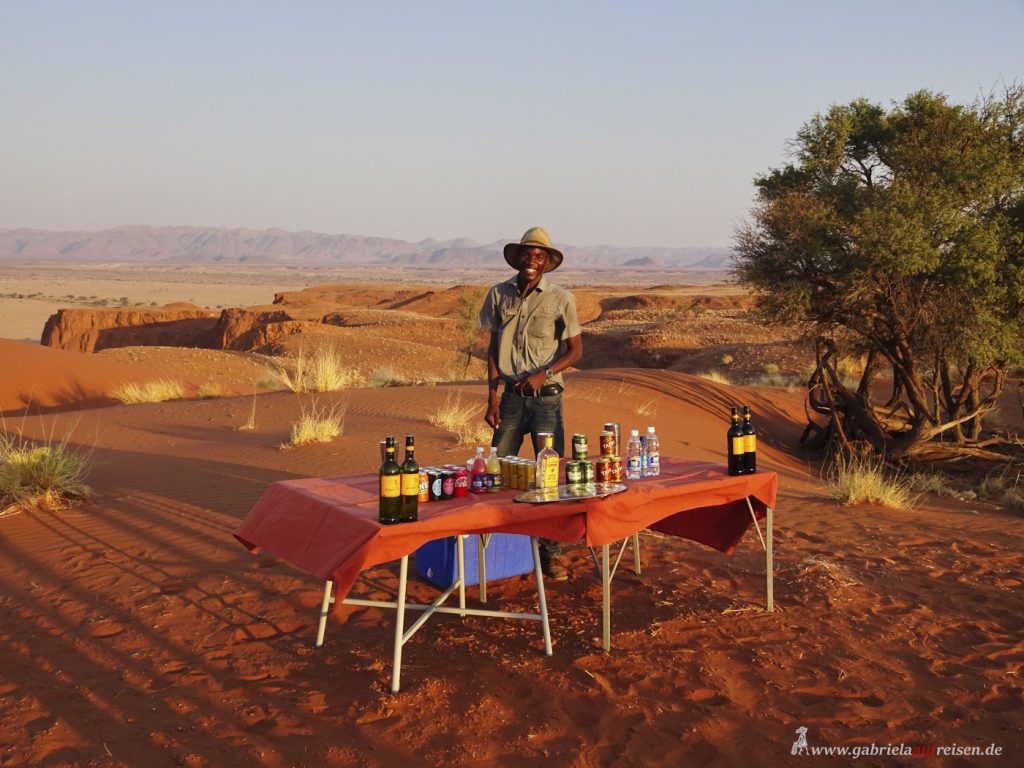
At sunset, a table is set up for us and equipped with various drinks. Very quickly the sun sets here and not only turns the sand totally red, but also dips the surroundings in a soft, orange light. Just wonderful! May this journey never come to an end….
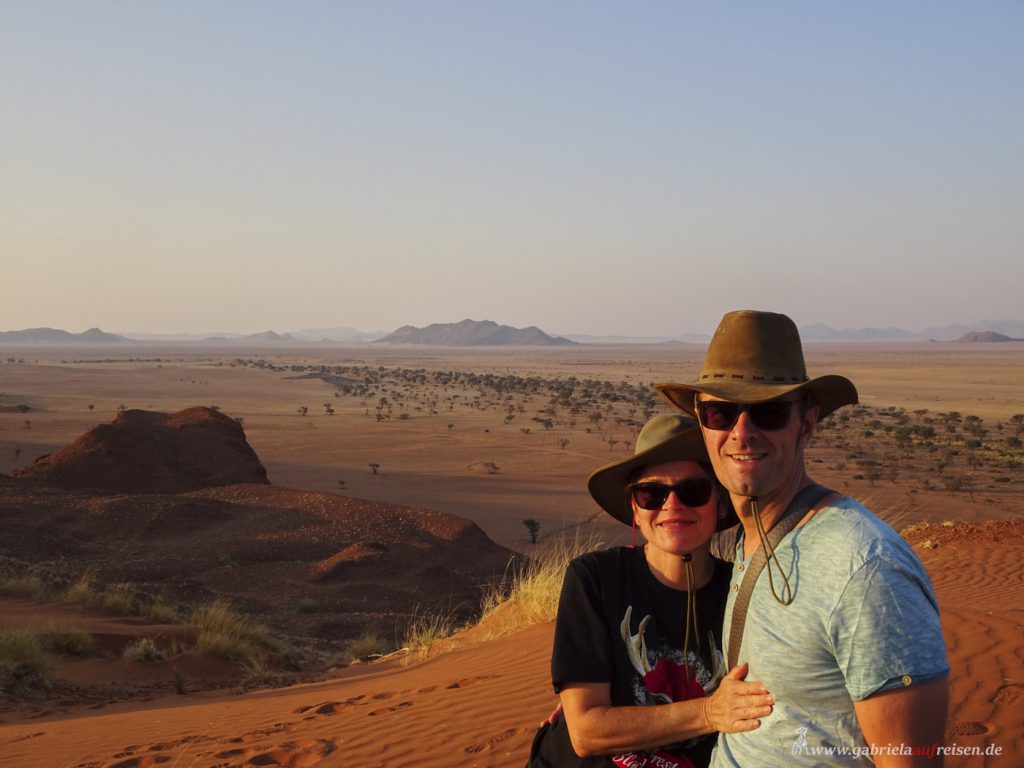
The guide wants to leave fast, because we still have a decent distance down to the lodge and in the dark this is no pleasure.
The next day will take us to the last accommodation of our trip. We are reluctant to say goodbye to the Sossusvlei and its enchanting colors.
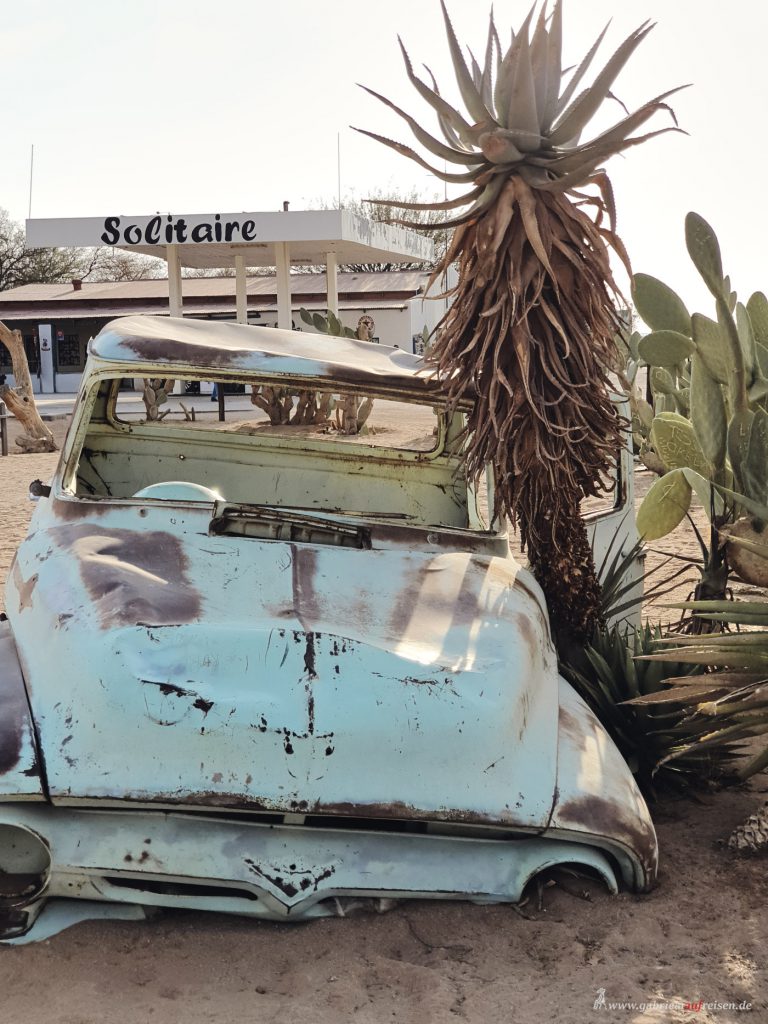
Conny´s Coffee
It goes again over bad slopes via Rehoboth in the mountains, to the direction of Windhoek. Our lunch is cooked in a solar oven, a specialty of Conny’s restaurant, which is on the way. A wonderful dish with fresh salad is waiting for us. Then comes the unique coffee ceremony, where we can taste various fair trade, coffees. Who would have thought that, in the middle of nowhere!
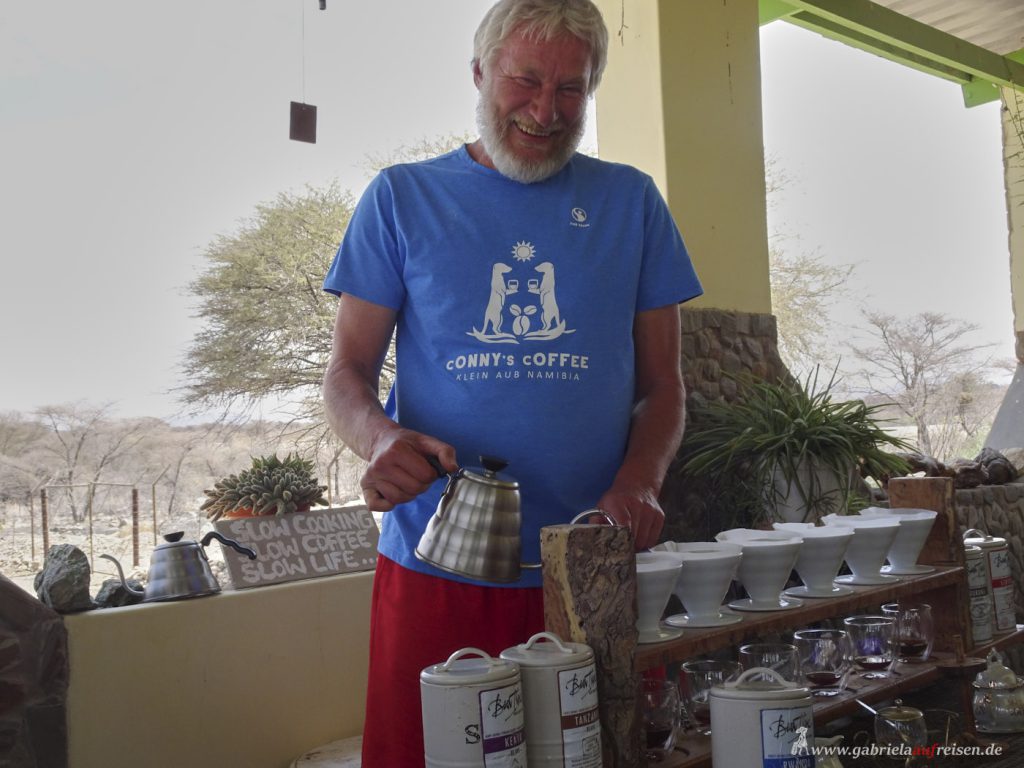
In the afternoon we reach the
Auas Safari Lodge
where we stay for the last two days of this fantastic trip.
The lodge is located in the Auas mountains and is home to many animals. Giraffes, oryxes, antelopes and even cheetahs and leopards, which we do not see on our game drive in the evening.
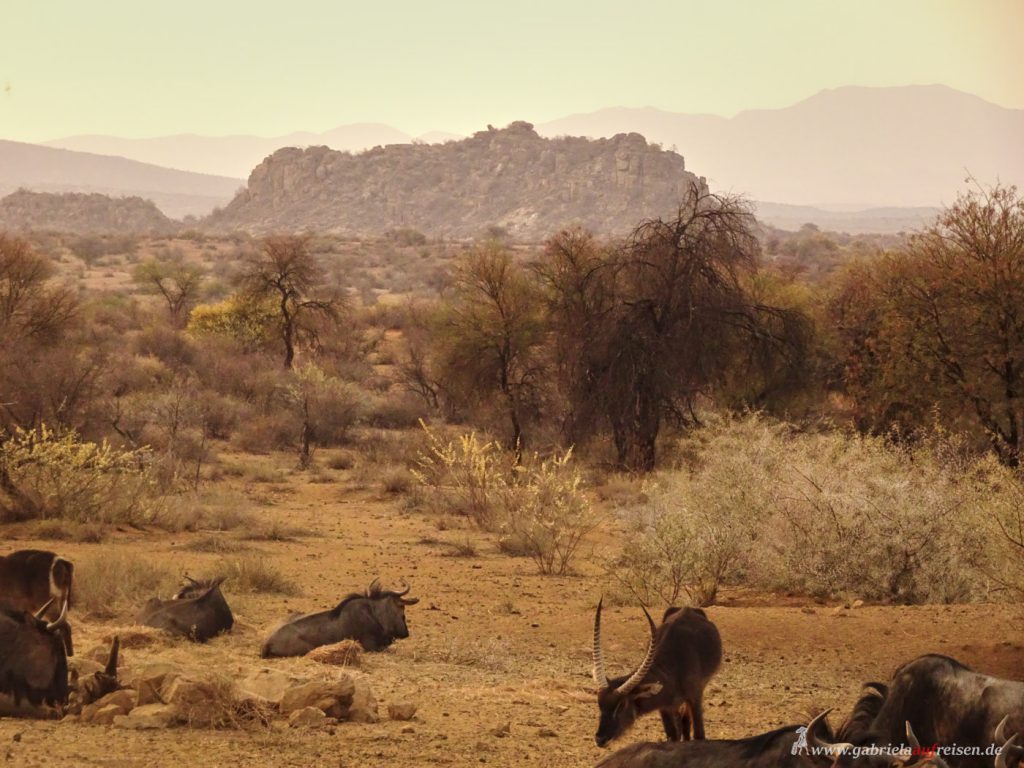
We are welcomed so kindly and nicely and feel incredibly comfortable here! The dining is very good, the terrace and the sunbathing lawn border directly on one of the feeding grounds of the lodge, so that we can observe kudus, warthogs, curious ostriches and many other animals up close.
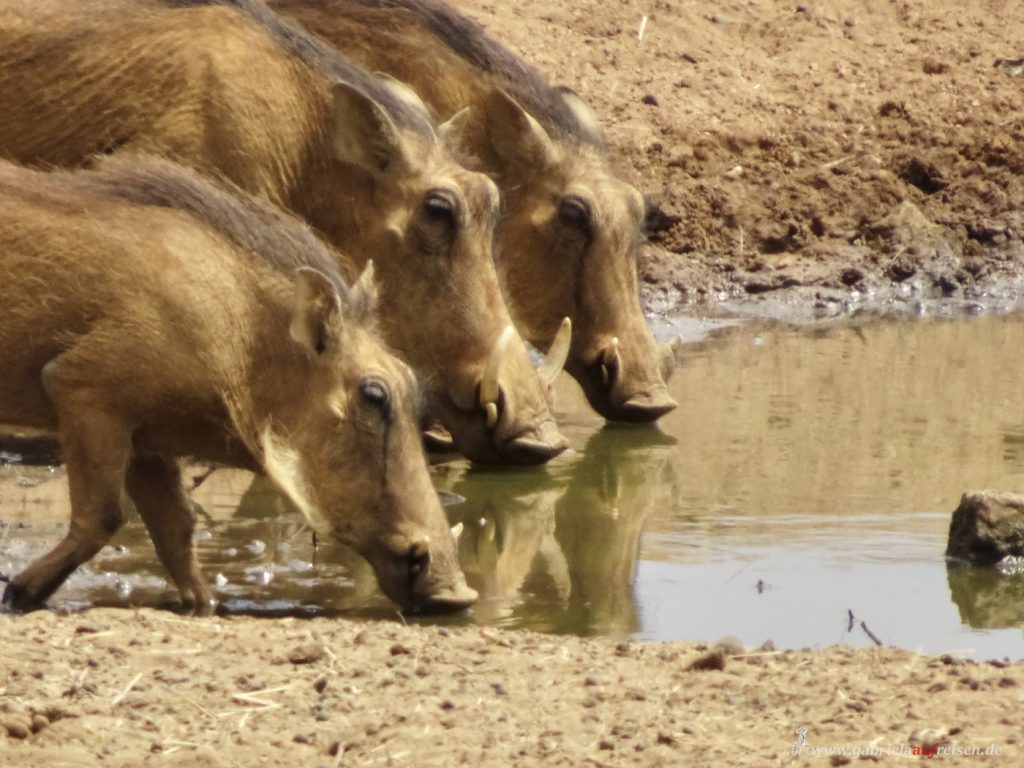
I don’t even need to get up from my sun berth. My book also remains unread, the spectacle of the animals is much more interesting, how they annoy each other and who is the boss at the waterhole. Due to this year’s severe drought, lodge owners all across the country have to feed the wild animals. Nevertheless, on our tour to another waterhole we see many dead animals. A feast for jackals and vultures, which of course multiply a lot this year.
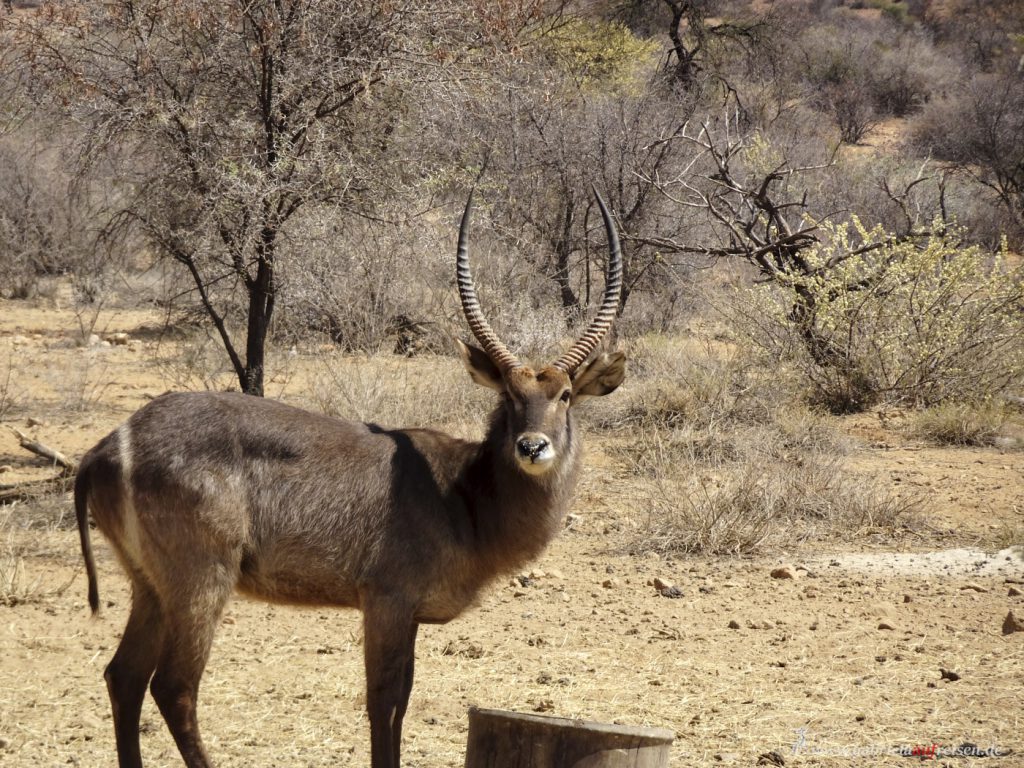
Hopefully it will rain extensively soon! We already see a few clouds, but they don’t want to bring rain yet.
So, after two days at this lodge we say goodbye. We drive to the airport. Unfortunately, this “journey of my life” is now over. But I’ll talk and think about it for a long time to come. And of course, I will advise my customers at the travel agency with shining eyes to make a “journey of their lives”.
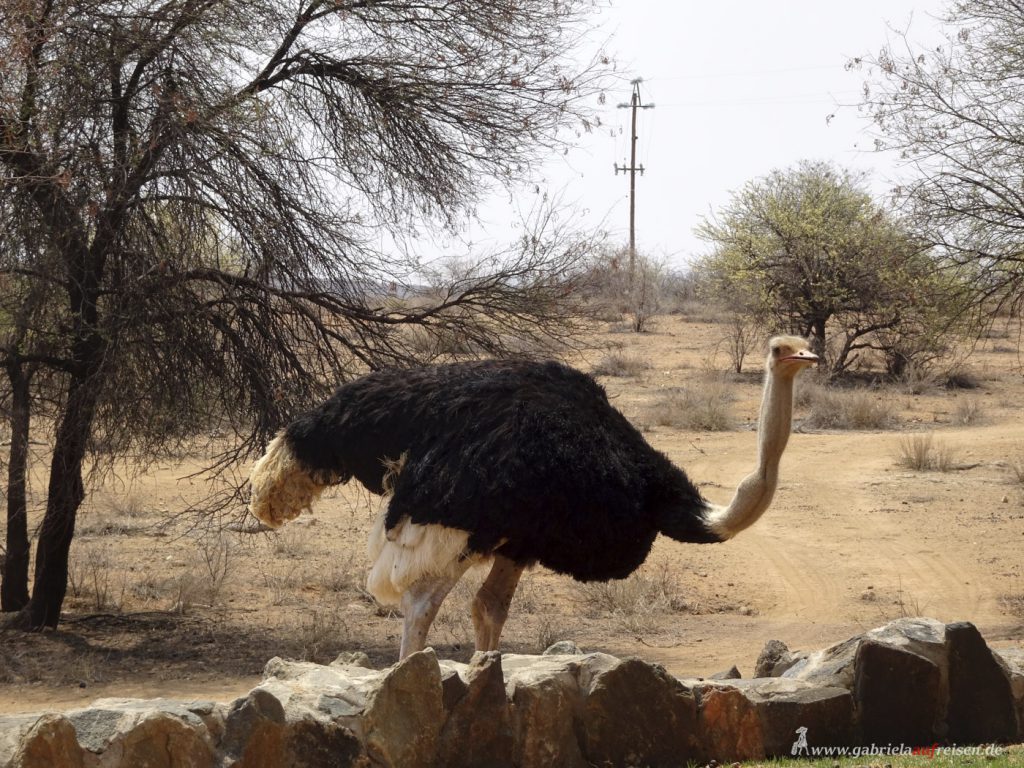
Who knows what you’ll see?!
If you liked what I wrote, then just subscribe to my newsletter. There are many more trips to come! You can also find out all the news on Facebook, Pinterest, TripAdvisor and of course on Instagram. I look forward to your comments and your “likes” here and there!
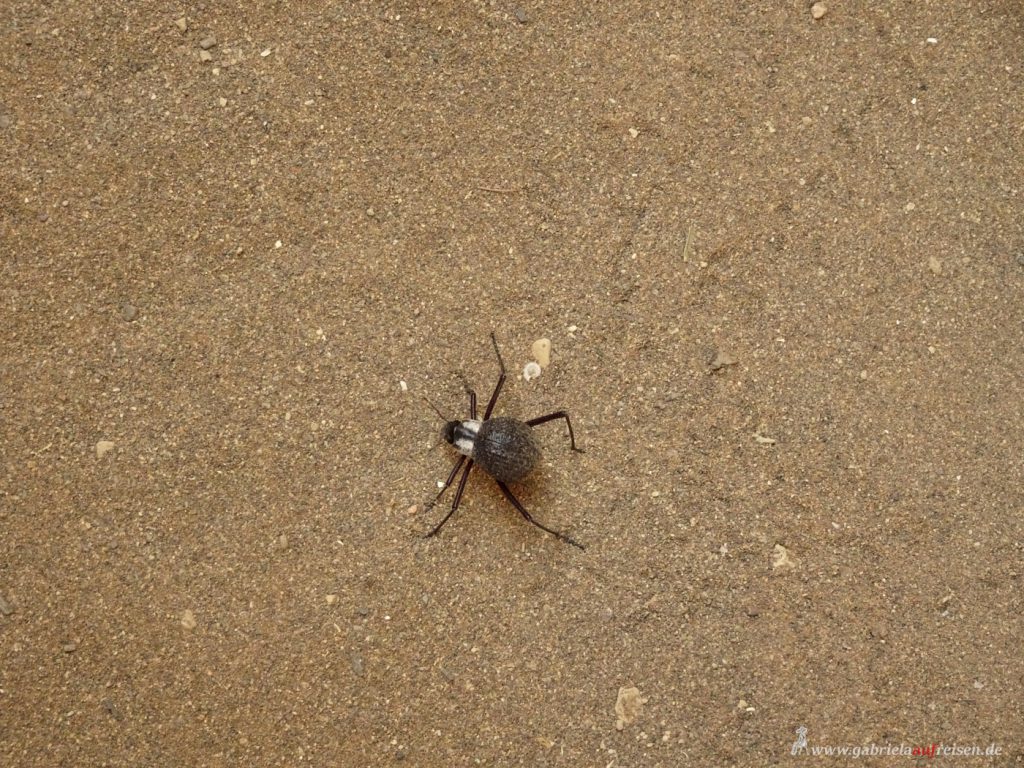
See you….
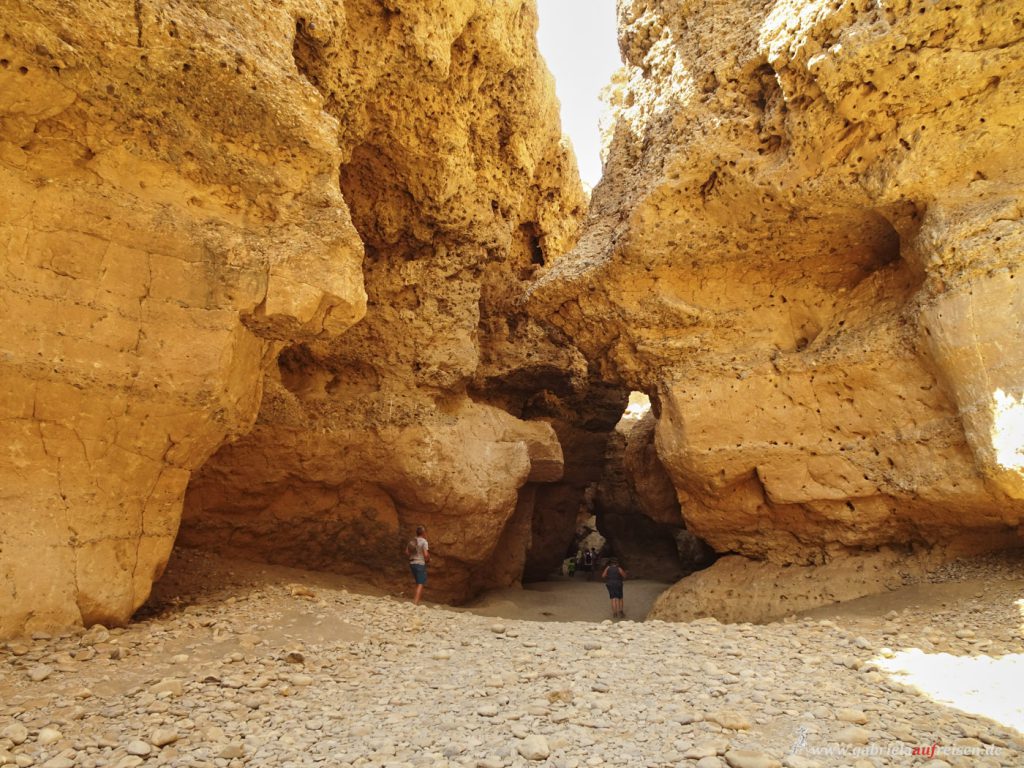
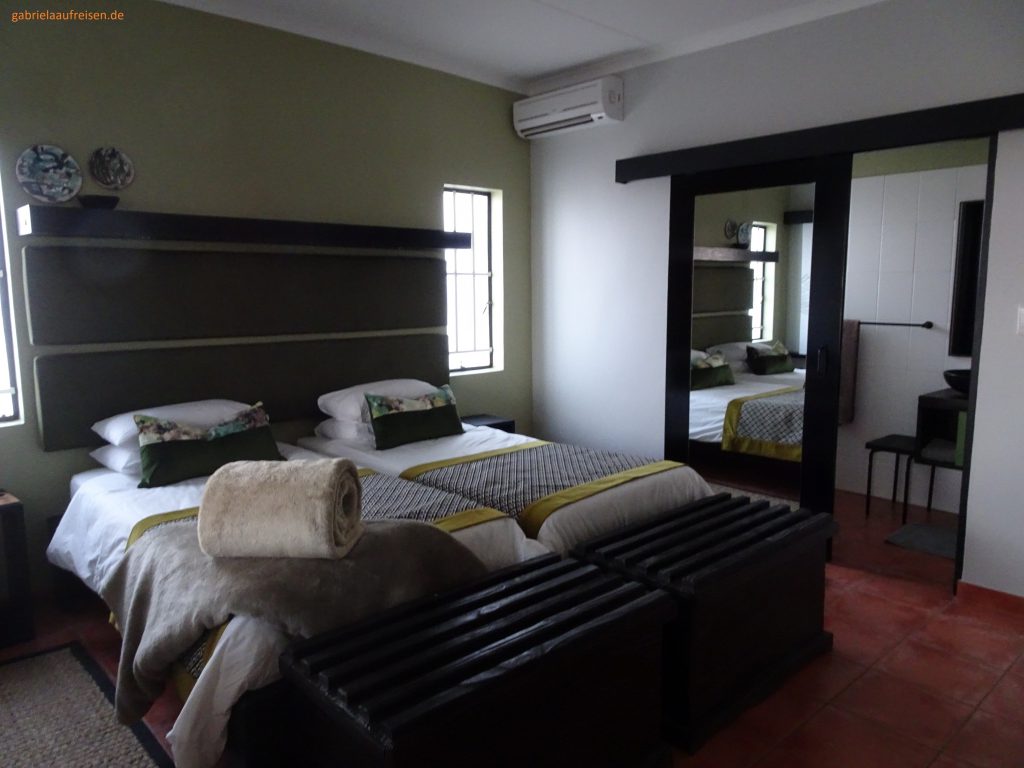
[…] like Africa and would like to read more about it? Go this way and guess where it […]
[…] nun an. Aber wir haben ja noch einige Tage. Jetzt geht es erstmal via Walvis Bay zur Sossusvlei. To the English […]
So viele Tiere! Unglaublich, das schaut sensationell aus. Afrika reizt mich ja generell nicht so, aber nach Namibia würd ich schon gern mal – eben wegen der Fauna und der Steppe. LG Barbara
Liebe Barbara,
in Namibia findet sicher jeder sein Lieblingstier und bei dieser schier unendlichen Weite ist das Landschaftserlebnis einfach unvergleichlich.
Liebe Grüße
Gabriela
Hi Gabriela,
what a beautiful place! I haven’t been to Namibia yet but all pictures I see are just amazing. It seems to be a wonderful place and definitely worth visiting. The sea, the desert – stunning nature!
Barbara
Dear Barbara,
you’re right, there is so much to see and to do and so few people. Yes, you should go one day…
See you there 😉
Gabriela
Liebe Gabriela,
ein sehr schöner Beitrag. Namibia steht auch ganz weit oben auf unserer Liste. Danke für die tollen Tipps!
Liebe Grüße
Ines und Thomas
Liebe Ines, lieber Thomas,
ein wunderschönes Land, das uns mit dem “Afrika-Virus” infiziert hat. Wir müssen wieder hin
Liebe Grüße
Gabriela
Das sieht atemberaubend aus! In Namibia waren wir noch nie, aber die Tierwelt dort wäre definitiv eine Reise wert.
Liebe Grüße von Sanne
Liebe Sanne,
ich wünsche euch, dass ihr es bald schafft. Die Tierwelt ist fantastisch!
Liebe Grüße
Gabriela
Namibia ist wirklich ein echtes Traumreiseziel.
Die Walvis Bay haben wir auf eigene Faust erkundet und auch ohne Schiff. Seehunde und Co gab es aber trotzdem in unzähliger Menge.
Danke für die schönen Erinnerungen.
Liebe Grüße, Katja
Liebe Katja,
das war wohl auch nicht unsere letzte Reise nach Namibia, dazu ist das Land zu vielfältig und die Tiere einfach fantastisch.
Liebe Grüße
Gabriela